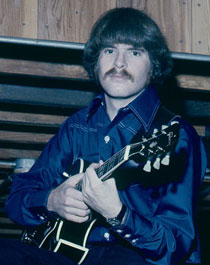 With the temperature dropping, it's time to find someone to keep you warm. Find your hookups with our online dating guide!
With the temperature dropping, it's time to find someone to keep you warm. Find your hookups with our online dating guide!

John Fogerty
Celebrities Home / Entertainment Home
“There is stuff that does happen that is bigger or beyond your little life. Facts don’t change, but sometimes you don’t understand it till years later. I had this urge, this urge to go to Mississippi.” — John Fogerty
It was 1990. Older brother Tom – whom John was not on speaking terms because of the legal trouble – was gone, having died of AIDS in September. John himself was now 45, and his last record, the poorly received Eye of the Zombie, was four years old. The pain over the Creedence Clearwater Revival breakup and plodding aftermath had barely softened over time, but enough for John to sing some old tunes for veterans of Vietnam on the Fourth of July, 1987. It was the first time John sang CCR in 15 years.
And yet there was a deeper void for John Fogerty, deeper than himself. Pragmatism aside, logic discarded, John had studied a map of Mississippi, talked with some folks, and trekked into the heart of the Delta on a pilgrimage with the hope of reclaiming both his passion and his soul. There, amid the swamps near Mt. Zion Baptist Church, standing at the purported grave of Robert Johnson, he could feel things changing. Fogerty was contemplative, recalling the myths and the feats of the bluesman. He couldn’t help but think of himself and how he had gotten to where he was: now middle-aged with a legendary past and things still to say. And so, there in the Mississippi Delta at Johnson’s final resting place, was born John Fogerty’s revival.
Following the lukewarm response to CCR’s seventh studio album Mardi Gras in 1972, the band folded, ending one of the most spectacular runs of a musical group in history, but not without bitterness, jealousy, and feelings of betrayal. The well-charted tension in the group, the desire for Fogerty to sustain his original voice, and the bouts with Saul Zaentz contributed to the decline. Fogerty’s reluctant foray into the legal arena stemmed from Zaentz, then-head of Fantasy Records, a company owning the distribution and publishing rights to CCR’s music. Fogerty, as frontman and chief songwriter, claimed the songs were his, and thus began a quagmire of legality that ballooned into fees well into the millions. For Fogerty, the mess was such a personal blow that he shunned everything Creedence Clearwater, from playing songs live to switching a radio station if he heard himself and his old band.
Fogerty plunged ahead immediately after CCR’s fracture into a solo career, first in 1973 with The Blue Ridge Rangers in which he played every instrument. A country album at a time when country was not too popular, among the traditional songs chosen for the record, “Jambalaya (On the Bayou)” turned into a hit. Two years later came John Fogerty, which Allmusic.com calls “underappreciated” and worthy of a listen. The opening track, “Rockin’ All Over the World,” set the tone for the rest of the record, but the album only climbed as high as #78 on the U.S. charts. The third solo album entitled Hoodoo for Asylum Records never even saw the light of day. Fogerty’s recent mediocre track record and low record sales contributed to withholding Hoodoo from release. Later, in the 1980s, Fogerty would instruct Asylum to destroy all of the Hoodoo material. Its completion in 1976 marked the beginning of a near ten year reclusiveness from recording and the music scene. That is to say John Fogerty did not see an end to his legal tumult during this time, but when he moved out of his native California into the mountains and pines of Oregon, content with spending his time hunting, it seemed John Fogerty had little use for singing, records, and music in general. It was the perfect setup for a comeback.
Centerfield climbed to the top in the United States, a blend of a style hearkening to the CCR days and with songs seen as veiled attacks at Fogerty’s detractors and enemies, not the least being Saul Zaentz with “Vanz Kant Danz,” the last track on the record. Of course, with Centerfield’s popularity also brought its share of legal issues, including Asylum suing Fogerty for plagiarizing himself (claiming “Old Man Down the Road” was too much like “Run Through the Jungle” by CCR; Fogerty successfully defended himself). Whatever success Fogerty may have enjoyed with the record was marred by the follow-up, 1986’s Eye of the Zombie. Even to this day John Fogerty refuses to play any material from it. Its dismal response prompted another hermitage from Fogerty, and this time, he was in need of serious soul searching.
Standing at the grave of Robert Johnson, whose many recordings in the 1930s would influence anyone who was anyone in rock n roll, John Fogerty owned up to what he had to do by first owning up to who he was. The bitterness over the 1972 breakup, the wrenching court cases over right (and pride) of ownership, the failure to reconcile with Tom, the apathetic reactions to the solo work, and his own place in the world pored out there in the Delta. “He’s the spiritual owner of those songs,” Fogerty found himself saying while thinking of Johnson’s recordings. “That’s just like you. Do you see it? You’re the spiritual owner. No matter what you’ve gone through, you wrote those songs. You created them. You lived those songs, and you’re the one who really can sing those songs with the true understanding of how they came into being.”
Fogerty began playing Creedence Clearwater Revival songs in 1992. His 1997 album Blue Moon Swamp won the Grammy for Best Rock Album of the Year. Deju Vu (All Over Again) was Fogerty’s 2004 album, reminiscent of the politically charged anthems from 1968 – 1972, but with a critical eye to the American politics of the 2000s. Finally, Revival in 2007 brought everything full circle for John Fogerty. And the dual meaning of the album’s title was not just a passing reference to the name of his old band, as we have seen. It was about John Fogerty himself, about who he was as a person and artist, about what he believed in and what he would fight for. John Fogerty never gave up.
 Tired of striking out? Check out these Dating Tips for all sorts of advice on how to finally get the girl! Also, we tell you all about some of the best online dating sites and how you can use them to hook up with more women!
Tired of striking out? Check out these Dating Tips for all sorts of advice on how to finally get the girl! Also, we tell you all about some of the best online dating sites and how you can use them to hook up with more women!
John on the Web
IMDb
Complete list of films featuring John on the soundtrack, and a comprehensive database of John’s on-screen appearances.
Official Site
John’s homepage features all the latest news in detail with plenty else to peruse.
Wikipedia
Career-oriented bio focusing on CCR and post-CCR.
“Fogerty v. Fantasy” Article
Extended Wikipedia article on the legal battle between Fogerty and his record company.
John on Video
AOL Video Interview
John appears on “Today” in 2007 to reflect.
2008 Grammy Pre-Show
John and wife chat with E!
Fogerty/Mellencamp in Concert
2005 footage from Indiana of John and John teaming up.
Fogerty Live, 2005
John sings “Have You Ever Seen The Rain?”
1986 Interview
John in a brief, rare interview.
John on the Radio
John’s solo career begins a year after CCR’s end, with The Blue Ridge Rangers in 1973 (with songs “She Thinks I Still Care” and “Today I Started Loving You Again” among others). John Fogerty (“Almost Saturday Night” and “Travelin’ High”) followed in 1975. Centerfield was John’s next released record in 1985 followed the very next year by Eye of the Zombie. Blue Moon Swamp brought John a Grammy in 1998, Déjà vu (All Over Again) was released in 2004, and Revival in 2007. Fogerty also released two live albums: Premonition in 1998 and The Long Road Home - In Concert in 2006.
John Says
On his view of the legal turmoil:
“I didn’t want Creedence on a K-Tel compilation next to Donna Sumner.”
On unreleased work:
“I usually destroy unreleased material. It has a way of coming back to haunt you.”
On returning to touring:
“I’m like a twenty two year old kid in a new band trying to get noticed and break through, because the vast majority of people have never seen me play live.”
You can follow us on Twitter and Facebook for content updates. Also, sign up for our email list for weekly updates and check us out on Google+ as well.










